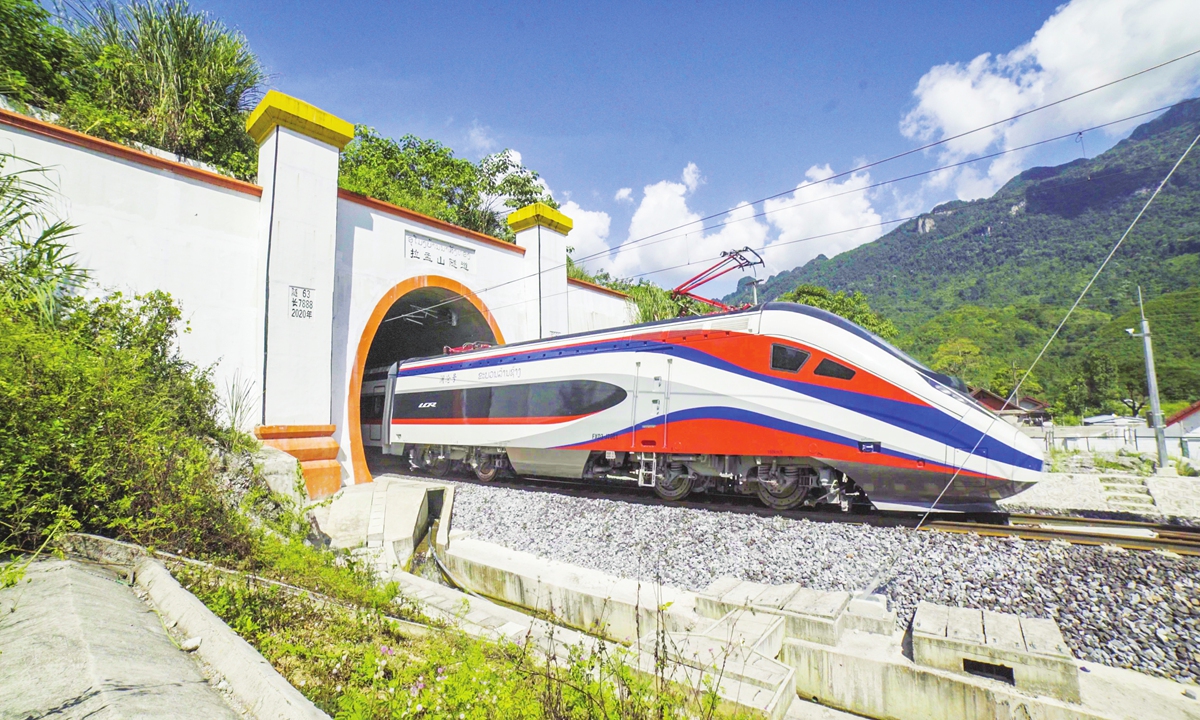
A section of the China-Laos Railway built by PowerChina Photo: Courtesy of PowerChina
Editor's Note:
Over the past 10 years, China has implemented a more active opening-up strategy, and the Belt and Road Initiative (BRI) has offered a popular platform for international cooperation. The joint construction of BRI spans different regions, development stages, and civilizations. China has signed over 200 Belt and Road cooperation documents with more than 140 countries, and more than 30 international organizations. In contrast with the growing voices for decoupling and unilateralism created by the US, the BRI, which advocates global cooperation and prosperity under a shared future, has provided a platform to boost living standards and foster unity, and has gained unprecedented recognition and has been embraced by countries around the world. As the initiative is set to welcome its 10-year anniversary next year, by reaching out to several industry experts and representatives, Global Times reporters tried to find what has made the initiative stronger and more popular worldwide, despite challenges.
Since the BRI was proposed in 2013, after years of development, it has become a pillar in providing a new driving force for global economic and trade development. More importantly, as a popular and practical international platform, it has promoted the building of a community with a shared future for mankind.
At a recent press conference before the opening of the 20th CPC National Congress, spokesperson Sun Yeli emphasized that the BRI is providing a new driving force for global economic growth.
As of June, the total trade volume of goods between China and countries along the BRI routes has reached about $12 trillion, and a large number of pragmatic cooperation projects have been implemented, delivering tangible contributions to local economic development as well as improvements to local living standards.
Opportunity to the worldWhile some countries are facing serious development challenges, mostly posed by infrastructure gaps, BRI provides opportunity to the world.
The BRI is a dream of many developing countries because greater facilities connectivity and establishment of economic cooperation can enhance the economic prosperity of partner countries, Maya Majueran, director of Belt&Road Initiative Sri Lanka, a Sri Lanka-based organization that specializes in BRI cooperation, told the Global Times.
"As a Chinese proverb says, 'If you want to get rich, build a road first.' This is a fair way of representing China's 30 years of economic development: invest in infrastructure by building roads and railroads to power GDP growth," Majueran noted, adding that "this is the main reason China's BRI is seen as an opportunity for the world."
One good example is the Power Construction Corporation of China (PowerChina), an important player in building the BRI. Despite global challenges and uncertainties, the company has actively participated in the construction of the BRI, with numerous achievements so far.
As of September, the state-owned energy infrastructure company has participated in construction projects in 45 of the 65 key countries along the BRI, according to the latest statement that the PowerChina sent to the Global Times on Wednesday.
Continuous effort As some Western countries are relentlessly advocating unilateralism and creating decoupling, the high inflation and the epidemic have added fuel to the deteriorated situation, posing unprecedented challenges to the world economy and trade.
Countries, especially developing countries, along the BRI routes, have been hit hard by changes in the international situation and the epidemic, and are in urgent need of more development funds, experts said, noting that the BRI is also in active response to the changes.
In order to more effectively promote the cross-regional cooperation and economic integration, "we will increase our efforts to guide the investment enthusiasm of Chinese enterprises to join the economic construction of the countries along the Belt and Road while at the same time innovate financial tools to encourage investment," Song Wei, professor from the institute of international relations at Beijing Foreign Studies University, told the Global Times on Wednesday.
For example, Chinese banks and local financial institutions cooperate in various forms of development financing in order to expand the capital pool for common development, Song noted.
To better cope with the global risks, including the so-called "debt issue" frequently raised by the West in regard to BRI projects, PowerChina said that the company will continue to adhere to business strategies including ensuring stable operation of projects while managing risks at controllable level and guaranteeing benefits for sustainable and win-win development.
China has made a big effort and contribution to help developing countries to carry out further construction, transformation and upgrading. The process of Chinese-style modernization and the theories we have formed are actually very good for current developing countries to avoid crises in the future, experts said.




